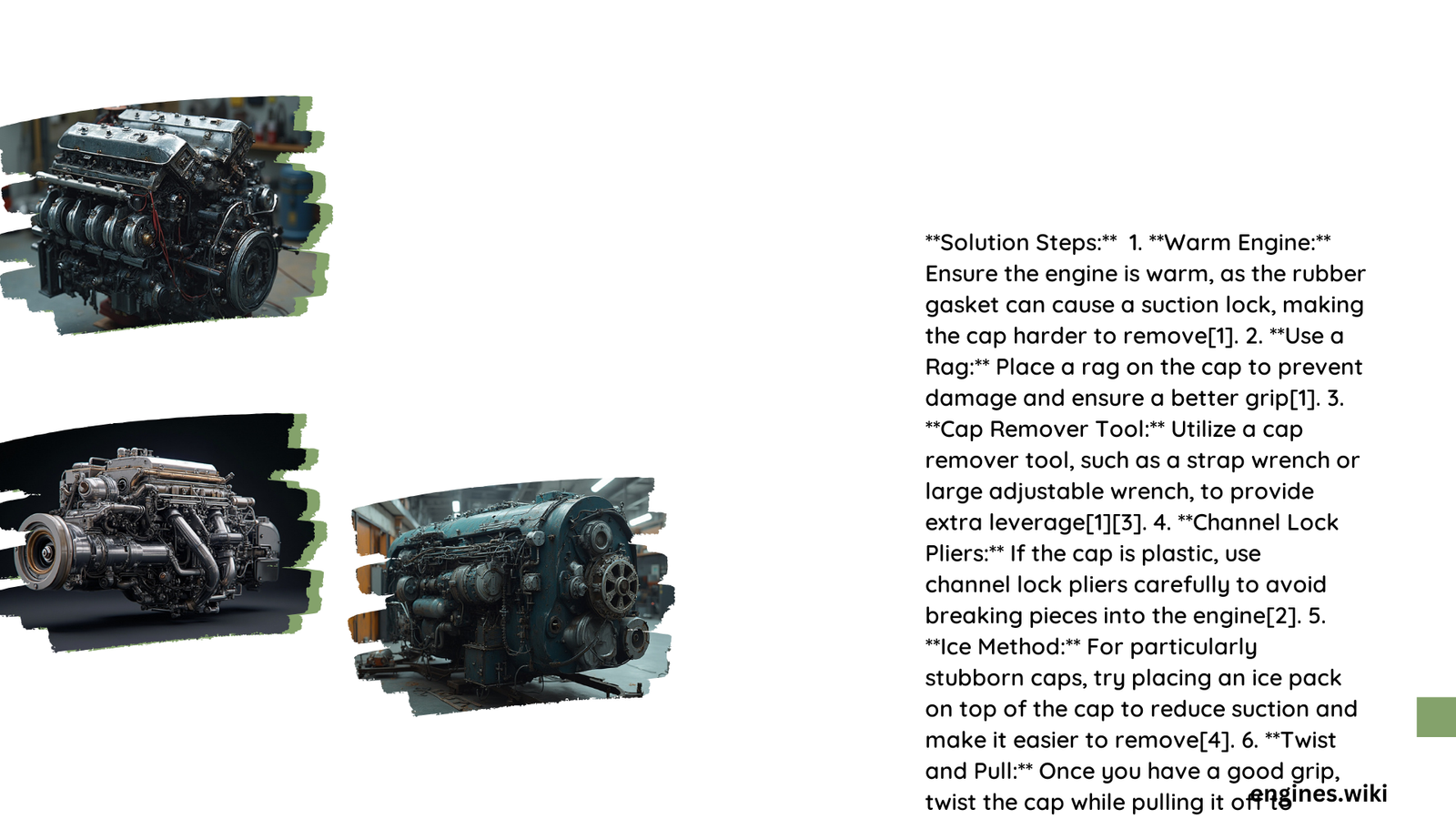A stuck engine oil cap can be a frustrating experience for vehicle owners. This issue can arise due to various factors such as degraded rubber seals, burnt oil residue, or corrosion. Understanding the causes and knowing effective removal techniques can save time and prevent damage to your vehicle. This comprehensive guide will explore the reasons behind a stuck oil cap, provide step-by-step solutions, and offer expert advice on how to handle this common automotive problem.
Why Can’t I Get My Engine Oil Cap Off?
Several factors can contribute to a stuck engine oil cap:
-
Degraded Rubber Seal: Over time, the rubber seal on the oil filler cap can deteriorate due to repeated heating and cooling cycles. This degradation can cause the cap to stick, especially in older vehicles like a 20-year-old VW Golf.
-
Burnt Oil Residue: Infrequent oil changes can lead to a buildup of burnt oil on the cap, making it difficult to remove. This issue has been reported in vehicles like the 2012 Toyota Camry.
-
Rust or Corrosion: Exposure to harsh weather conditions can cause rust or corrosion on the threads of the oil filler cap or its surrounding area, resulting in a stuck cap.
What Are the Common Vehicle Makes and Models Affected?

While any vehicle can potentially experience a stuck oil cap, some models have been reported more frequently:
- VW Golf (older models)
- Honda Civic (specifically the 2.2 56 Reg model)
- Toyota Camry (2012 model)
How Can I Remove a Stuck Engine Oil Cap?
Here are some effective techniques to remove a stuck engine oil cap:
- Mallet and Wood Block Method:
- Place a wood block on the cap to distribute force evenly
- Gently tap the wood block with a mallet to loosen the cap
-
Be careful not to use excessive force to avoid damage
-
Penetrating Oil Application:
- Spray penetrating oil (e.g., WD-40 or Liquid Wrench) onto the threads
- Allow the oil to sit for a few minutes to penetrate
-
Attempt to remove the cap after the oil has had time to work
-
Strap Wrench or Pliers Technique:
- Use a strap wrench for caps with smooth surfaces
- Employ pliers for caps with textured surfaces
- Exercise caution to avoid slipping and damaging surrounding areas
What Are the Recommended Torque Specifications?
Torque specifications for oil filler caps vary by vehicle make and model. Generally:
- Tighten the cap just enough to ensure a secure seal
- Avoid over-tightening to prevent damage
- Some vehicles may specify a torque of around 1-2 Nm (newton-meters)
- Always consult your vehicle’s manual for specific instructions
What Are the Risks of Over-Tightening the Oil Cap?
Over-tightening the oil filler cap can lead to several issues:
- Damage to the cap threads
- Cracking or breaking of the cap itself
- Potential oil leakage
- Necessity for replacement parts
Which Tools Are Most Effective for Removing a Stuck Oil Cap?
| Tool | Description | Best Use Case |
|---|---|---|
| Mallet and Wood Block | Gentle tapping to loosen cap | Non-invasive method for slightly stuck caps |
| Strap Wrench | Provides secure grip without slipping | Caps with smooth surfaces |
| Pliers | Offers extra grip for textured caps | When strap wrench is unavailable |
| Penetrating Oil | Chemical aid to loosen rust or corrosion | Caps stuck due to corrosion or rust |
What Are the DIY Methods for Removing a Stuck Oil Cap?
- Mallet and Wood Block Method:
- Place wood block on cap
- Gently tap with mallet
-
Attempt to unscrew cap
-
Penetrating Oil Application:
- Apply oil to threads
- Let sit for a few minutes
-
Try to remove cap
-
Strap Wrench or Pliers Technique:
- Use tool to gain extra grip
- Carefully attempt to unscrew cap
- Avoid slipping to prevent damage
Are There Any Chemical Aids That Can Help?
Yes, penetrating oils can be highly effective:
- WD-40
- Liquid Wrench
- PB Blaster
These products can help loosen rust or corrosion on the threads, making cap removal easier.
What Is the Estimated Cost for Professional Assistance?
If DIY methods fail, professional help may be necessary:
- Cost typically ranges from $20 to $100
- Price varies based on issue complexity and labor rates
- Some service centers may include this as part of routine maintenance
How Can I Prevent My Oil Cap from Getting Stuck in the Future?
To avoid future issues with stuck oil caps:
- Regularly clean the cap and surrounding area during oil changes
- Apply a thin layer of clean engine oil to the threads before reinstalling
- Avoid over-tightening the cap
- Use the correct torque specification for your vehicle
- Consider replacing the cap if the rubber seal shows signs of wear
By following these preventive measures, you can significantly reduce the likelihood of encountering a stuck oil cap in the future.
Remember, if you’re unsure about any aspect of vehicle maintenance, it’s always best to consult with a professional mechanic to avoid potential damage or safety issues.
